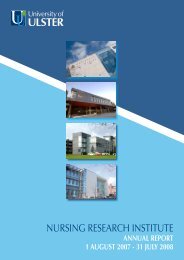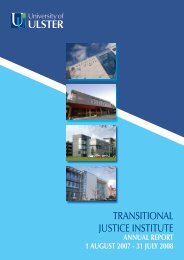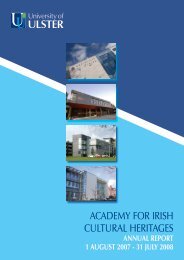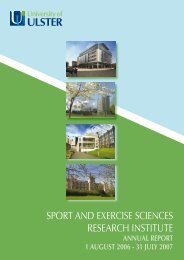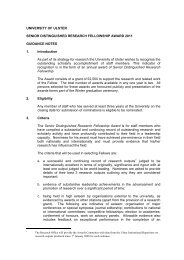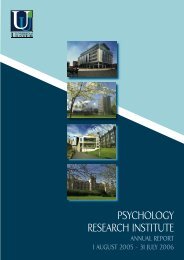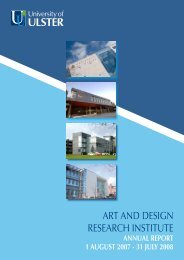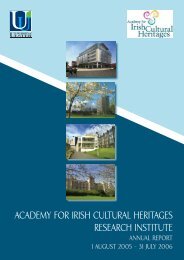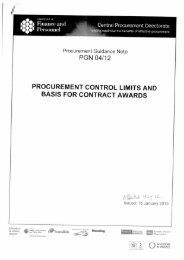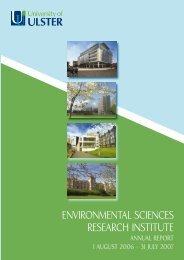Publications:Barnes CA, O’Hagan BMG, Howard CV, McKerr G; Verification <strong>of</strong> cell viability at progressively higher scanning forcesusing a hybrid atomic force and fluorescence microscope; Journal <strong>of</strong> Microscopy, 228: 185-189, November 2007Edwin Lamers, X Frank Walboomers, Maciej Domanski, Joost te Riet 3 , George McKerr, Barry M O’Hagan, CliffordA Barnes, Lloyd Peto, Falco CMJM van Delft, Regina Luttge, Louis Winnubst, Han JGE Gardeniers and John A Jansen;Nanogrooved substrates influence osteoblast-like cell behavior and extracellular matrix deposition; (submitted toNano Letters)Dr O’Hagan and his colleagues are currently preparing manuscripts detailing sample preparation and imagingparameters for biological dual beam microscopy, and comparative electron imaging techniques. In addition, a number<strong>of</strong> joint publications resulting from our collaborations are expected in the near future.Dr Clifford Barnes<strong>Research</strong> AssistantContact Details:T: +44 (0)28 70323028c.barnes@ulster.ac.ukDuring the period 1 st August 2007 to 31 st July 2008, Clifford was employed as a post- doctoral <strong>Research</strong> Assistanton a 3 year contract in the NanoInteract Project, headed by Pr<strong>of</strong>essor Howard and Dr George McKerr.This work involved testing the potential genotoxicity <strong>of</strong> amorphous silica nanoparticles through the use <strong>of</strong> theComet Assay. The results obtained during this period directly challenged a widely cited abstract, which had declaredthat amorphous silica was genotoxic. A close collaboration with the N<strong>of</strong>er Institute <strong>of</strong> Occupational Medicinein Poland was established to ensure results were repeatable across laboratories. A draft paper was presented inPoland at a NanoInteract group meeting. This paper was subsequently submitted for publication in Nano Letters.Clifford’s main <strong>research</strong> interests involve imaging the uptake <strong>of</strong> nanoparticles in cultured cells using a range <strong>of</strong>high-resolution techniques such as Fluorescence and Confocal Microscopy, Environmental, Transmission and HighVacuum Scanning Electron Microscopy and Cryo-Dual Beam Scanning Electron Microscopy. These techniques, inconjunction with stereology, will be used to quantify nanoparticle uptake in a study, which will take place inpartnership with <strong>University</strong> College Dublin.Environmental Scanning Electron imagesFig 3. - Secondary electron image taken in ESEM. Filopodia (labelled F) andlamellipodia (labelled L) are visible. A piece <strong>of</strong> debris (labelled D) is indicatedFig 4. - ESEM backscattered image. Ceria nanoparticles are visible asbright spots. Nucleoli (labelled N) and debris (labelled D) are visible.26
Clifford is responsible for the routine maintenance, alignment and operation <strong>of</strong> the FEI Centre for Advanced Imaging(electron optics including transmission electron microscopy, Environmental scanning electron microscopy, Cry<strong>of</strong>ocused ion beam microscopy). He liaises closely with FEI field engineers and customer support in fault diagnosisand repair. Development and optimization <strong>of</strong> cryo dual beam microscopy for biological samples is the main thrust <strong>of</strong>his work and is ongoing. This includes developing protocols for sample preparation and imaging parameters for bothambient and cryogenic conditions, and have working ‘recipes’ for chemically fixed and unfixed cellular monolayers,resin embedded material and cryo-fractured samples.He has trained a number <strong>of</strong> other users in the use <strong>of</strong> our electron microscopes to the point where they are capable<strong>of</strong> using the instrumentation unsupervised. or with minimal supervision.In addition to the ongoing development <strong>of</strong> biological cryo dual beam microscopy, Clifford is also closely involvedin a number <strong>of</strong> other <strong>research</strong> projects and collaborations with external companies and institutions. These includethe following:• Transmission electron microscopy <strong>of</strong> Nanotube structure (NIBEC).• Cryo-Dualbeam microscopy <strong>of</strong> osteoblast response to nanogrooved substrates. (<strong>University</strong> Nijmegen MedicalCentre, joint publication pending).• FIB nano-machining <strong>of</strong> AFM probe tips (Yael Dror, Oxford).• Cryo FIB, variable pressure ESEM Mitochondrial imaging. (<strong>University</strong> <strong>of</strong> Leicester, joint publication pending).• Temperature variation in SEM chamber during cryo operation (NIBEC).• TEM polymer structure and formation (Chemistry at Queens <strong>University</strong>).• Assistance with Nanotoxicology <strong>research</strong> (NanoInteract).• Assistance with fat emulsion <strong>research</strong> (CAST award with Unilever <strong>Research</strong>, Vlaardigan).• Assistance with investigations into bacterial adhesion to cells (CAST award with Unilever <strong>Research</strong>, Port Sunlight).• Preliminary imaging <strong>of</strong> oil bearing rock core samples. (collaboration with Corex).Publications:Barnes CA, O’Hagan BMG, Howard CV, McKerr G; Verification <strong>of</strong> cell viability at progressively higher scanning forcesusing a hybrid atomic force and fluorescence microscope; Journal <strong>of</strong> Microscopy, 228: 185-189, November 2007Mr Andreas Elsaesser<strong>Research</strong> AssistantContact Details:T: +44 (0)28 70324765a.elsaesser@ulster.ac.ukAndreas Elsaesser studied physics at the Technical <strong>University</strong>, Munich and the <strong>University</strong> <strong>of</strong> Liverpool, United Kingdom.He graduated in 2006 with a Dipl.Phys. (corr. M.Sc.) in Surface and Interface Physics, Nuclear Physics and Astrophysicsand finished his studies investigating Complex Plasmas with ultra-fast Laser-Tomography.Andreas is currently employed as a <strong>research</strong> assistant in the BioImaging <strong>Research</strong> Group working for NanoInteract,a FP6 project investigating interaction mechanisms between nanoparticles and biological systems.<strong>Research</strong> Interests:Interaction <strong>of</strong> Nanoparticles and biological systemsIn order to understand the principle interaction mechanisms <strong>of</strong> nanoparticles and living cells, we measure nanoparticleuptake ratios and pathways <strong>of</strong> nanoparticles in cells using Transmission electron microscopy and Scanning electronmicroscopy.27
- Page 1: BIOMEDICAL SCIENCESRESEARCH INSTITU
- Page 4 and 5: 1 Foreword by the Pro Vice-Chancell
- Page 6 and 7: 2 Foreword by the Research Institut
- Page 8 and 9: The BMSRI Research StructureThe BMS
- Page 10 and 11: BMSRI Core FacilitiesContact: Karen
- Page 12 and 13: of Metabolomics, pharmacy, nutritio
- Page 14 and 15: BMSRI Academic Heads new Regional N
- Page 16 and 17: 4. BIOMEDICAL GENOMICS RESEARCH GRO
- Page 18 and 19: Recent Funding Initiatives:C-TRIC:
- Page 20 and 21: Dr Mateus Webba da SilvaLecturer in
- Page 22 and 23: 5. BIOIMAGING RESEARCH GROUPResearc
- Page 24 and 25: developmental alterations that mani
- Page 26 and 27: Publications:Bigot S, Lucas L, Morr
- Page 30 and 31: We also measure the genotoxic effec
- Page 32 and 33: 6. CANCER AND AGEING RESEARCH GROUP
- Page 34 and 35: Professor Anthony P McHaleProfessor
- Page 36 and 37: Professor Stephanie McKeownProfesso
- Page 38 and 39: an Alzheimer Research Trust collabo
- Page 40 and 41: JM, Waugh DJJ; Dexamethasone potent
- Page 42 and 43: have wider applications in vivo, in
- Page 44 and 45: Inter-relationships between diet an
- Page 46 and 47: Flatt PR; Effective surgical treatm
- Page 48 and 49: These areas are the subject of seve
- Page 50 and 51: Dr YHA Abdel-WahabSenior Lecturer i
- Page 52 and 53: Dr VA GaultLecturer in Molecular Bi
- Page 54 and 55: McClean PL, Irwin N, Hunter K, Gaul
- Page 56 and 57: Publications:Duffy NA, Green BD, Ir
- Page 58 and 59: 8. MICROBIOLOGY AND BIOTECHNOLOGYRE
- Page 60 and 61: Publications:Graham RJL, Graham C,
- Page 62 and 63: analyses. However there is still a
- Page 64 and 65: Plessas S, Bekatorou A, Koutinas AA
- Page 66 and 67: Biochemical studies/ viral evasion
- Page 68 and 69: Dr Stephen McCleanLecturer in Prote
- Page 70 and 71: environmental remediation and as ro
- Page 72 and 73: 9. NORTHERN IRELAND CENTRE FOR FOOD
- Page 74 and 75: 26-28 Sept 2007: International Seaf
- Page 76 and 77: Dr Barnes has developed expertise i
- Page 78 and 79:
Dr Alison GallagherSenior Lecturer
- Page 80 and 81:
In addition, results of a pilot stu
- Page 82 and 83:
Dr Maeve KerrResearch AssociateCont
- Page 84 and 85:
Memberships of External Committees/
- Page 86 and 87:
Indicators of Esteem:Professor McNu
- Page 88 and 89:
were examined. The intervention and
- Page 90 and 91:
Within this work both short-term an
- Page 92 and 93:
micronutrient supplementation at a
- Page 94 and 95:
10. STEM CELL & EPIGENETICS RESEARC
- Page 96 and 97:
Publications:Lees-Murdock DJ, Lau H
- Page 98 and 99:
Publications:Lees-Murdock DJ, Lau H
- Page 100 and 101:
11. SYSTEMS BIOLOGY RESEARCH GROUPT
- Page 102 and 103:
Kravtsov V, Swain M, Schuster A, Du
- Page 104 and 105:
Dr Daniel BerrarLecturer in Biomedi
- Page 106 and 107:
Zhang et al; Incorporating Feature
- Page 108 and 109:
Bala P, Baldridge K, Benfenati E, C
- Page 110 and 111:
In addition there is a growing them
- Page 112 and 113:
Clinical work involves development
- Page 114 and 115:
In 2009 he was appointed Chairman o
- Page 116 and 117:
Stevenson TR, Goodall EA and Moore
- Page 118 and 119:
Dr Raymond BeirneLecturer in Optome
- Page 120 and 121:
Dr Julie McClellandLecturer in Opto
- Page 122 and 123:
Graham JE, Moore JE, Moore JE, McCl
- Page 124 and 125:
Research Staff:Dr David OrrSenior R
- Page 126 and 127:
Dr Victoria McGilliganResearch Asso
- Page 128 and 129:
13. Externally Funded Projects duri
- Page 130 and 131:
Grant Holder Anderson, Prof RSFundi
- Page 132 and 133:
Funding Body Royal Irish AcademyAmo
- Page 134 and 135:
14. BIOMEDICAL SCIENCES RESEARCH IN
- Page 136 and 137:
Student: Simon GenglerTitle: Effect
- Page 138 and 139:
Student: Anisha MazumdarTitle: Anal
- Page 140 and 141:
Student: Clare RyanTitle: How does
- Page 142 and 143:
CONGRATULATIONS TO THE FOLLOWING PO



